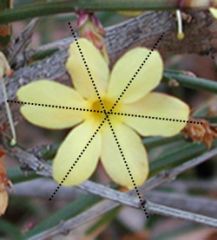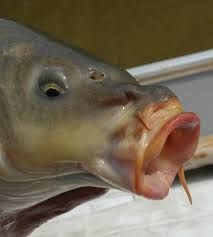![]()
![]()
![]()
Use LEFT and RIGHT arrow keys to navigate between flashcards;
Use UP and DOWN arrow keys to flip the card;
H to show hint;
A reads text to speech;
39 Cards in this Set
- Front
- Back
|
Deuterostomes |
Any member of the phyla (Chordata, Hemichordata, Echinodermata, Chaetognatha) in which the anus appears first,developing at or near the blastopore, cleavage is radial and indeterminate, and the mesoderm and coelom form from outgrowths of the primitive gut. |
|
|
Vertebrates |
An animal of a large group distinguished by the possession of a backbone or spinal column, including mammals, birds, reptiles, amphibians, and fishes. |
|
|
Invertebrates |
An animal lacking a backbone, such as an arthropod, mollusk, annelid, coelenterate, etc. The invertebrates constitute an artificial division of the animal kingdom. |
|
|
Radial symmetry |

Symmetry around a central axis, as in a starfish or a tulip flower. |
|
|
Water vascular system |
-a series of branching fluid-filled tubes and chambers |
|
|
Tube feet |

Elongated, fluid-filled appendages that contribute to the water vascular system. |
|
|
Podium |
a foot. |
|
|
Echinodermata/Echinoderms |
Echinoderms are a phylum of marine animals. The adults are recognizable by their radial symmetry, and include such well-known animals as starfish, sea urchins, sand dollars, and sea cucumbers, as well as the sea lilies or "stone lilies"
ih-kahy-nuh-durm |
|
|
Asteroidea |
Starfish or sea stars are star-shaped echinoderms belonging to the class Asteroidea.
as-tuh-roi-dee-uh |
|
|
Pharyngeal gill slits |

openings in throat. |
|
|
Notochord |
Stiff, supportive, but flexible rod that runs length of body.
Function: |
|
|
Dorsal hollow nerve cord |
-runs length of body |
|
|
Cephalochordata |
-fish-like animals (body, movement)
Ex: lancelets, amphioxus |
|
|
Urochordata |
-pharyngeal gill slits for feeding and gas exchange
Ex: tunicates, sea squirts |
|
|
Vertebra |
cartilaginous or bony structures. |
|
|
Cranium |
The skull, especially the part enclosing the brain.
|
|
|
Forebrain |
In vertebrates, the region of the brain housing sense of smell. |
|
|
Midbrain |
In vertebrates, the region of the brain associated with vision. |
|
|
Hindbrain |
In vertebrates,the region of the brain associated with balance and hearing. |
|
|
Cerebrum |
The principal and most anterior part of the brain in vertebrates, located in the front area of the skull and consisting of two hemispheres, left and right, separated by a fissure. It is responsible for the integration of complex sensory and neural functions and the initiation and coordination of voluntary activity in the body. |
|
|
Cerebellum |
The part of the brain at the back of the skull in vertebrates. Its function is to coordinate and regulate muscular activity. |
|
|
Medulla oblongata |
This section of the brain helps transfer messages to the spinal cord and the thalamus in the brain from the body and controls breathing, heart function, blood vessel function, digestion, sneezing, and swallowing. Sensory and motor neurons from the forebrain and midbrain travel through the medulla. |
|
|
Cartilage |
A firm, elastic, flexible type of connective tissue of a translucent, whitish or yellowish color; gristle. |
|
|
Bone |
The hard connective tissue forming the substance of the skeleton of most vertebrates, composed of a collagen-rich organic matrix impregnated with calcium, phosphate, and other minerals. |
|
|
Endoskeleton |
The internal skeleton or framework of the body of an animal |
|
|
Exoskeleton |
An external covering or integument, especially when hard, as the shellsof crustaceans |
|
|
Jaws |
Either of two bones, the mandible or maxilla, forming the framework of the mouth. |
|
|
Gnathostomes |
Gnathostomata are the jawed vertebrates. |
|
|
Tetrapods |
A four-footed animal, especially a member of a group that includes all vertebrates higher than fishes. |
|
|
Amniotic egg |
The type of egg produced by reptiles, birds, and prototherian (egg-laying) mammals (amniotes), in which the embryo develops inside anamnion. |
|
|
Albumen |
Provides water and mechanical support |
|
|
Gill arches |
-curved regions of tissues between the gills |
|
|
Gills |
The paired respiratory organ of fishes and some amphibians, by which oxygen is extracted from water flowing over surfaces within or attached to the walls of the pharynx. |
|
|
Somites |
Each of a number of body segments containing the same internal structures, clearly visible in invertebrates such as earthworms but also present in the embryonic stages of vertebrates. |
|
|
Neural crest cells |
Are a transient, multipotent, migratory cell population unique to vertebrates that gives rise to a diverse cell lineage. |
|
|
Protrusible jaw |

In fish, a structural arrangement of the jaws that enables the animal to protrude (extend) or withdraw the mouth at will. When fully protruded, the cavity of the mouth is enlarged to form a funnel-like space facilitating the uptake of food. |
|
|
Pharyngeal jaw |
secondary specialized jaw consisting of modified gill arches |
|
|
Ectothermy |
Body temperature is controlled by an organisms surroundings. |
|
|
Endothermy |
Physiological generation and regulation of body temperature by metabolic means : the property or state of being warm-blooded. |

